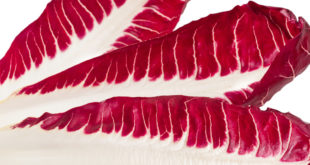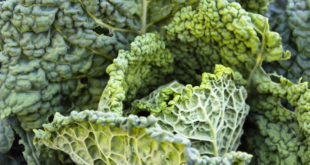Salad greens are a great source of vitamins, especially A, C, and K. Many are high in iron, some even have surprising amounts of calcium. Add that in with the fact that many of them contain disease-fighting phytonutrients, and it’s hard to find a reason not to go for leafy greens whenever you can. Here’s a guide to salad greens, which includes details about different varieties of greens as well as information about selecting, storing, and serving.
How to choose the best salad greens?
Salad greens should be vibrant and crisp–avoid signs of wilting, yellowing or brown spots. Head varieties should be tightly furled, not loose or limp.
How to store salad greens?
It depends on the green, but for most lettuces, simply wrap the bunch with paper towels or a damp kitchen towel, then place them in an unsealed bag and refrigerate. Keep loose leaves like baby spinach, watercress, and arugula in a more tightly-sealed plastic bag. Most should keep nicely for 3-4 days. Kale can be stored in a loose bag without wrapping, but keep it in the coldest part of your fridge–and use it as soon as you can after buying it. It can become unpleasantly bitter if stored for too long.
What is good in salad greens?
As a general rule, the darker the green, the more nutrient-dense it is. Intensely hued greens like kale and spinach contain huge amounts of vitamins such as A, C, iron, and calcium–and have found their rightful place on “superfoods” lists everywhere. On the other hand, paler-leaved bunches like iceberg lettuce or endive rank lower on the nutritional scale. But they’re still low-cal, high-fiber, and generally very hydrating.
How to prepare salad greens?
It depends on the variety, but one universal tip is to dry, dry, dry! Making sure the greens are bone-dry after washing them helps the dressing cling to the leaves and reduces the risk of a soggy salad. A balance of flavours and textures makes for the best salads. Top your salad greens with something sweet (like fruit), something crunchy (like nuts), something pungent or salty (like cheese), and then use a nice, light dressing flavoured with fresh herbs (like vinaigrette).
What kinds of salad greens are there?
So many we could never count them all! Here are some of the most popular:
Lettuce Family
The most well-known of salad greens, lettuce is renowned for its mild, sometimes even sweet flavor that goes well with just about anything. Lettuce grows in all shapes and sizes, but generally falls into one of two categories: head lettuce or loose-leaf lettuce. Head lettuce grows in a tight ball, whereas loose-leaf lettuce grows in, well, looser bunches. It’s also one of the most popular veggies to grow in home gardens, so if you decide to grow it, you may want to go the loose-leaf route–instead of needing to harvest the entire head of lettuce at once, you can just grab a few leaves here and there as needed. You already know lettuce is low-calorie (clocking in at right around 10 calories per cup), but it’s solid nutrition-wise, too. Most varieties of lettuce are especially good sources of vitamin A and potassium. So eat up!
- Butter lettuce. This yellow-green head lettuce boasts an almost creamy–and yes, buttery–texture. Usually sold in small-to-medium heads, butter lettuce’s diminutive size and wonderful texture makes it the perfect topper for burgers or sandwiches. Popular varieties include Bibb, Boston and red butter lettuce.
- Iceberg. Iceberg lettuce gets a bum rap–and sure, it’s not the most nutritious of salad greens. But it’s got its place! The tightly packed leaves on dense, heavy heads contain more water than most, making it an excellent choice if you’re looking for foods that hydrate. Cut this neutral-tasting head lettuce into wedges or thick slices for a popular wedge-type salad, or slice it into strands and throw it in with other greens to add a bit of crunch.
- Leaf lettuce. Leaf lettuce is also sometimes called loose leaf, or it’s often named by its color–green leaf or red leaf. No matter what you call it, this mild lettuce with large, frilly-edged leaves, is one of the most familiar. Its mildly sweet, delicate taste and nice, crisp bite make it the perfect lettuce for sandwiches and burgers. It’s also a popular lining for hors d’oeuvres platters–and while it’s pretty, we’ve got to admit that it’s tough to see such a great green go to waste!
- Oak leaf. Oak leaf lettuce is visually very similar to leaf lettuce, but with more of an oak leaf shape. If you prefer to steer clear of bitter greens, this super-mellow, sweet lettuce is for you. Red oak leaf lettuce, with its frilly edges and reddish-purple hue, is a particularly nice choice if you’re looking to pretty-up your plate.
- Romaine. Arguably the king of salad greens (and certainly one of the most popular), romaine boasts a light, almost grassy taste and a satisfying crunch. It’s THE green for Caesar salads and the perfect wrapper for all kinds of delicious fillings. The crunchy rib can sometimes sport a bitter aftertaste, so cut the ribs out if you don’t like them. Romaine isn’t just delicious, it’s also particularly rich in folic acid and vitamin K.
Chicory Family
Very closely related to lettuce, chicory tends to have a more bitter, in-your-face taste in comparison to its milder brethren. Chicories can be a confusing bunch–depending on your region, any of its family members might simply be referred to as “chicory.” Part of the confusion stems from the fact that oftentimes, each type of green is actually a different part of the plant, or parts of the plant at various growth stages. No matter what they’re called, their bold flavors and robust composition mean chicory greens pair well with more assertive flavors. Think pungent cheeses, nuts, and pickled veggies.
- Belgian endive. Thanks to its elegant, sturdy leaves, endive is excellent for appetizers–just nudge a little dip into each leaf’s “cup,” and set the leaves out for easy finger food. Its sweet flavor–with just a hint of bitterness–also makes it a wonderful addition to salads. Interestingly, endive is grown almost entirely underground, without sunlight. This helps develop its sweet flavor and preserve that signature ivory hue.
- Escarole. Sturdy, wide-leaved, and frilly-edged, escarole can look a lot like green leaf lettuce. As far as chicory goes, escarole tends to be the least bold of the bunch. The greener parts are lightly bitter and spicy; the paler interior is milder because it hasn’t seen as much sunlight as the outer leaves.
- Frisee. Frisee is kind of, well, frizzy. Its feathery, pale green leaves have a nice, bitter bite, making it a popular addition to salad mixes. A bonus to frisee? Unlike many salad greens, you can assemble a frisee salad a few hours ahead of time–it keeps surprisingly well.
- Curly Endive. Curly outer leaves and a light green hue characterize curly endive. The bitter taste mellows as you move toward the pale center. Its sturdy leaves lend a zippy crunch to mixed green salads.
- Radicchio. This super-crunchy green is actually not green, but usually red or purple with white veins. It’s a bold choice raw, with rather bitter and spicy flavor that mellows considerably when cooked. Try grilling or roasting it for a surprisingly sweet result. Raw, it’s often used as a supporting actor, adding a bit of color and bite to mixed-green salads, but radicchio also stands quite well on its own, too.
Brassica Family
The Brassica family encompasses a wide variety of sub-species that include vegetables like cauliflower and cabbage. Brassicas are a member of the mustard family, and are also referred to as cruciferous vegetables. In general, veggies in this category are particularly nutrient-rich–they contain a good amount of phytonutrients, which may ward off cancer and other diseases.
- Arugula. This popular green features small, flat, frilly-edged leaves and a notoriously peppery bite that sometimes falls on the side of bitter. One of my favorite ways to enjoy arugula is to toss it in a light, lemony vinaigrette and serve it over a simple fresh-out-of-the-oven white pizza. Arugula is especially high in vitamin K.
- Kale. The superfood! All the hype surrounding kale is for good reason–it’s high in fiber and its nutrient content is off the charts. And we adore its earthy, slightly grassy taste. And Oh My Veggies contributor Julia has a new all-kale cookbook coming out this summer. (We can’t wait!) The many varieties of kale–such as curly, baby, lacinato–help ensure it’ll never get old even if you eat it several days a week. Kale is as versatile as it is nutritious–it’s wonderful in salads, soups, pasta, smoothies.
- Mizuna. A Japanese mustard green, this petite, spiky-edged leaf has mingled in mesclun mixes for ages. Recently, though, this spicy little number is finding a following all its own.
- Watercress. Watercress’s tiny, delicate leaves pack a powerful bite–the tangy, peppery flavour gives a distinctly piquant punch to salads. It’s also especially rich in antioxidant vitamins A & C. It commonly grows along the banks of rivers and streams; for the best flavour, foragers prefer to pluck the leaves from those plants that haven’t yet flowered.
Other Salad Greens
These greens might not belong to one of the more common families, but they stand up all on their own. From forager favorite purslane to the ever-popular spinach, here a few more delicious salad greens:
- Mache. This cute little green hails from Europe, where it volunteered prolifically between rows of corn, hence its alternate name: Corn Salad. Its tiny, lightly velvety leaves taste sweet and almost nutty, lending itself to a variety of salad preparations. It’s especially rich in nutrients, too–ounce for ounce, it contains even more iron than spinach.
- Mesclun. Mesclun is actually not one type of green–it’s a mixture of many. But it’s so common–you can find several pre-mixed salad bags and boxes in just about any grocery store in North America–that we thought we’d cover it here. Mesclun originated in France, and purportedly the word “mesclun” originates from the French word “mesclar” which means “to mix.” It can contain any number of salad-friendly greens ranging in tastes from neutral to bitter and from feathery to crunchy textures. When you’re not sure which green to use in a salad, just go for a bag of mesclun–it’ll usually get you there.
- Purslane. Largely considered a weed in North America, purslane is a fast-growing succulent that’s earned a following among foragers. Often described as “juicy” and “lemony,” tiny purslane leaves make up a unique salad all on their own, or they add wonderful flavor when scattered amongst other greens. Health-wise, no other green is higher in omega-3 fatty acids than purslane.
- Spinach. Popeye was on to something! Spinach is extremely rich in nutrients, and its mild, lightly herbal taste makes it so easy to tuck into salads, wraps, and smoothies that even so-called spinach haters might not even know it’s there. Stealth health! There are a few varieties out there, but the spinach most of us are familiar with–both smaller-leaved baby spinach and full-grown spinach–has smooth, sturdy, deep green leaves.
 bfc.green Promoting Green Lifestyle
bfc.green Promoting Green Lifestyle


